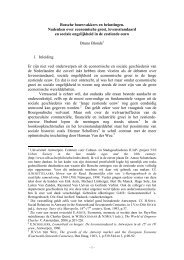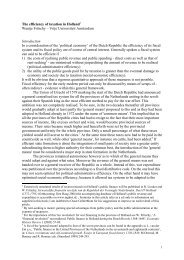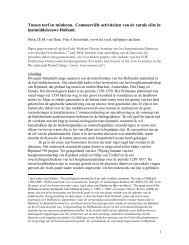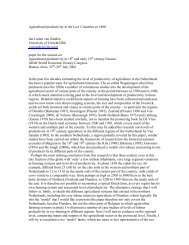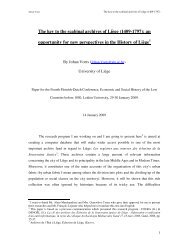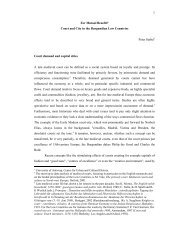Amsterdam as the cradle of modern futures and options trading ...
Amsterdam as the cradle of modern futures and options trading ...
Amsterdam as the cradle of modern futures and options trading ...
You also want an ePaper? Increase the reach of your titles
YUMPU automatically turns print PDFs into web optimized ePapers that Google loves.
little evidence for derivatives <strong>trading</strong> in Venice o<strong>the</strong>r than <strong>the</strong> discounting <strong>of</strong> <strong>the</strong> paghe, <strong>the</strong><br />
lender’s claim on interest payments, which occurred in <strong>the</strong> mid-fifteenth century. 56<br />
If forwards, <strong>futures</strong>, <strong>and</strong> <strong>options</strong> failed to materialize in <strong>the</strong> Venetian Republic, <strong>the</strong><br />
most likely explanation lies in <strong>the</strong> insufficient volume <strong>of</strong> <strong>the</strong> market for bonds. This w<strong>as</strong><br />
caused by <strong>the</strong> accumulation <strong>of</strong> prestiti in <strong>the</strong> h<strong>and</strong>s <strong>of</strong> civic <strong>and</strong> religious institutions,<br />
foreigners, <strong>and</strong> o<strong>the</strong>r long-term investors, in combination with <strong>the</strong> state’s renunciation <strong>of</strong> new<br />
bonds issues after 1450. 57 The lack <strong>of</strong> a voluminous secondary market also prevented Dutch<br />
government bonds to become a vehicle for speculation before <strong>the</strong> late seventeenth century. As<br />
early <strong>as</strong> 1570 various cities in Holl<strong>and</strong> <strong>and</strong> Brabant had begun to issue obligations to bearer. 58<br />
Indeed, by 1650 <strong>the</strong>se bonds constituted no less than 60% <strong>of</strong> public debt in <strong>the</strong> Dutch<br />
Republic. However, <strong>the</strong> bulk <strong>of</strong> <strong>the</strong> obligations remained in <strong>the</strong> h<strong>and</strong>s <strong>of</strong> <strong>the</strong> political elite,<br />
trustees <strong>of</strong> estates, institutions <strong>of</strong> civil welfare, <strong>and</strong> o<strong>the</strong>r investors buying to hold <strong>and</strong> not to<br />
trade. 59 In <strong>the</strong> absence <strong>of</strong> suitable paper from <strong>the</strong> public sector, it w<strong>as</strong> left to <strong>the</strong> private<br />
market to create an <strong>as</strong>set sufficiently liquid to set <strong>of</strong> <strong>the</strong> world’s first derivatives market.<br />
In <strong>the</strong> l<strong>as</strong>t decade <strong>of</strong> <strong>the</strong> 16 th century, <strong>Amsterdam</strong> commerce entered a new ph<strong>as</strong>e with<br />
<strong>the</strong> launch <strong>of</strong> pioneering voyages to Asia, organized by various companies <strong>of</strong> <strong>Amsterdam</strong><br />
merchants. 60 The merger between <strong>the</strong>se companies into <strong>the</strong> VOC in 1602 resulted in <strong>the</strong><br />
creation <strong>of</strong> a joint-stock company with transferable shares. The transferability <strong>of</strong> shares,<br />
designed merely to allow participants to liquidate <strong>the</strong>ir investment at any given time, induced<br />
speculative <strong>trading</strong> from <strong>the</strong> very day <strong>the</strong> subscription register w<strong>as</strong> closed. The fabulous<br />
returns <strong>of</strong> <strong>the</strong> first pioneering ventures, combined with <strong>the</strong> provision that payment <strong>of</strong> shares<br />
could be spread over four years, led many merchants to subscribe in <strong>the</strong> anticipation <strong>of</strong><br />
revenues from earlier companies whose ships had not yet returned to <strong>Amsterdam</strong>. O<strong>the</strong>r<br />
merchants speculated on price rises that would follow future gains <strong>of</strong> <strong>the</strong> new company.<br />
[add figure 1: Monthly transfers <strong>of</strong> shares <strong>of</strong> <strong>the</strong> <strong>Amsterdam</strong> Chamber <strong>of</strong> <strong>the</strong> VOC, calculated<br />
<strong>as</strong> a percentage <strong>of</strong> <strong>the</strong> total stock <strong>of</strong> capital, 1603-1612 (with six months’ moving average)]<br />
The brisk trade in VOC stock from March 1603 onwards is clear from <strong>the</strong> share transfers laid<br />
down in <strong>the</strong> ledgers <strong>of</strong> <strong>the</strong> <strong>Amsterdam</strong> Chamber (Figure 1). In <strong>the</strong> first five years <strong>of</strong> <strong>the</strong><br />
company’s existence already a third <strong>of</strong> <strong>the</strong> capital subscribed in <strong>Amsterdam</strong> changed h<strong>and</strong>s.<br />
Regular forward trade began once investors had paid up <strong>the</strong>ir shares in full. The prices in 33<br />
notarial contracts for <strong>the</strong> future delivery <strong>of</strong> shares, concluded in <strong>the</strong> first nine months <strong>of</strong> 1607,<br />
reveal <strong>the</strong> divergent expectations <strong>of</strong> traders (Figure 2). Forward <strong>trading</strong> fur<strong>the</strong>r incre<strong>as</strong>ed in<br />
8



